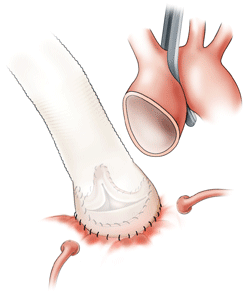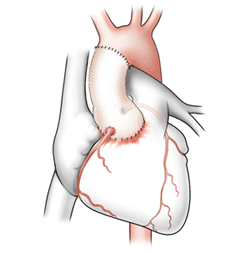Guide to Valve Sparing Aortic Root Replacement (David Procedure)
During Valve Sparing Root Replacement (also called the David Procedure, to give credit to the surgeon who initially conceived the operation, Tirone David, MD), the patient's aortic valve is kept (although it may be repaired and reimplanted) and reconnected to a new section of aortic tissue. By preserving the native aortic valve, patients avoid the need for lifelong anticoagulation therapy (coumadin).
The patient is placed on the heart-lung machine (cardiopulmonary bypass), which takes over the function of the heart and lungs during the operation.

Step 1: The heart is cooled and stopped and a clamp is placed across the aorta. The aorta is transected (divided) just above where the coronary arteries originate. The coronary ostia (openings) are removed as small buttons of tissue. The remainder of the ascending aorta is removed except for the valve tissue.

Step 2: Sutures (stitches) are placed under the valve and passed outside of the aortic annulus (ring of tissue surrounding the valve). A proper vascular graft is selected and attached to the heart with the prepared sutures.

Step 3: The valve is then carefully positioned within the graft to eliminate leaking. A fair bit of customized tailoring is then performed to ensure that the valve leaflets will open and close properly. The valve tissue is completely attached to the graft with a continuous suture technique. Two small holes are created in the graft for reattachment of the coronary arteries.

Step 4: Step 4: Finally, in select cases, the end of the graft is attached to the aortic arch while the brain is carefully protected with a special perfusion technique known as antegrade cerebral perfusion (ACP).
Next Steps
If you are in need of help for an aortic condition, we’re here for you. Call us now at (844) 792-6782 or fill out our online form to get started today.
